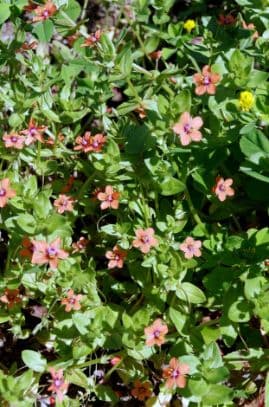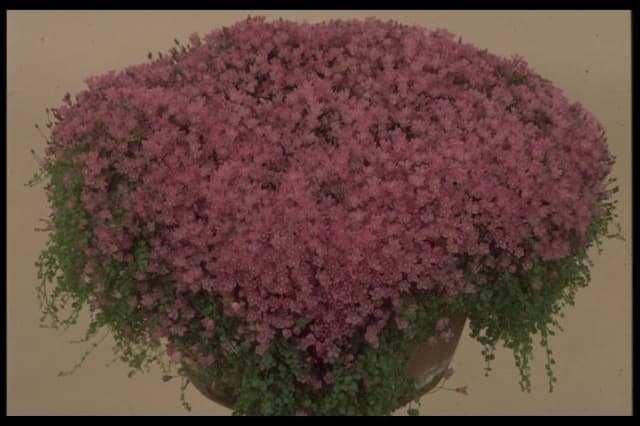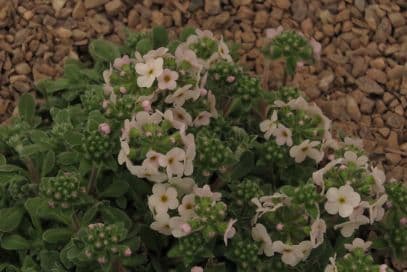Japanese Primrose Primula japonica (Pf)

ABOUT
Primula japonica, commonly known as Japanese primrose, is a charming perennial plant that brings a pop of color to woodland gardens or moist, shady areas. The most striking feature is its beautiful flowers, which bloom in a striking tiered arrangement, resembling a pagoda. These flowers come in various shades, typically vibrant pinks and purples, with a yellow center that adds a striking contrast. The leaves of Japanese primrose are basal, meaning they grow in a rosette at the base of the plant. They are broadly lance-shaped with a slightly wrinkled texture and create a lush green backdrop that emphasizes the beauty of the blossoms above. The individual flowers are borne on long, erect stems that rise above the foliage and each whorl, or tier of the pagoda, is spaced out, giving the stem a distinctive, laddered look. The entire plant has a delicate yet robust presence in the garden, often flowering in late spring to early summer. The overall effect of Japanese primrose in bloom is a stunning vertical accent that is soft yet eye-catching, with a romantic appeal thanks to its layered blooms and endearing coloration.
About this plant
 Names
NamesFamily
Primulaceae.
Synonyms
Japanese Primrose, Candelabra Primrose, Japanese Cowslip.
Common names
Primula japonica A.Gray
 Toxicity
ToxicityTo humans
Primula japonica, commonly known as Japanese primrose, is not reputed to be toxic to humans. There is no well-documented evidence of toxicity associated with the ingestion of Japanese primrose, and it is generally considered safe in terms of not causing poisoning. However, it is always advisable to exercise caution and avoid ingesting any plant material unless it is known to be safe for consumption.
To pets
Japanese primrose is not known to be toxic to pets. There are no commonly reported cases of poisoning in pets such as dogs and cats from ingestion of Primula japonica. As with humans, toxicity is unusual, but pet owners should still prevent their animals from consuming plants that are not meant for pet consumption to avoid any potential gastrointestinal upset or allergic reactions.
 Characteristics
CharacteristicsLife cycle
Perennials
Foliage type
Deciduous
Color of leaves
Green
Flower color
Varies
Height
1-1.5 feet (30-45 cm)
Spread
1-1.5 feet (30-45 cm)
Plant type
Herb
Hardiness zones
5
Native area
Japan
Benefits
 General Benefits
General Benefits- Attracts Pollinators: Primula japonica is known to attract bees, butterflies, and other beneficial pollinators to the garden, aiding in the pollination of nearby plants.
- Aesthetic Appeal: With its bright, colorful flowers that bloom in the spring, the candelabra primrose adds significant beauty and visual interest to garden spaces.
- Habitat Enrichment: Provides shelter and breeding spots for a variety of small insects and fauna within a garden ecosystem.
- Low Maintenance: Primula japonica is relatively easy to care for once established and doesn't require extensive upkeep, making it suitable for novice gardeners.
- Moisture Indicator: This plant prefers moist conditions, so its presence can indicate areas in the landscape where water collects or soil retains moisture.
- Soil Stabilization: The root system of Primula japonica can help reduce soil erosion, especially in damp areas where its growth is robust.
- Seasonal Interest: The plant’s unique tiered blooms provide an interesting visual during late spring, a period after most spring bulbs have finished flowering and before the full flush of summer blooms.
- Educational Use: It can be used in educational settings such as schools and botanical gardens to teach about plant life cycles and horticulture.
 Medical Properties
Medical Properties- Primula japonica, commonly known as Japanese primrose, has been traditionally used in some cultures for its anti-inflammatory properties.
- It is said to contain saponins, which may have expectorant and mild anti-inflammatory effects.
- The plant has been used in herbal medicine for the treatment of rheumatoid arthritis and gout, likely due to its purported anti-inflammatory action.
- Some sources refer to its use as an emollient to soothe skin irritations although scientific evidence is limited.
 Air-purifying Qualities
Air-purifying QualitiesThis plant is not specifically known for air purifying qualities.
 Other Uses
Other Uses- Primula japonica can be used as a natural dye for fabrics, imparting soft yellow to green hues depending on the mordant used.
- The flowers can be crystallized or candied to decorate desserts and provide a subtle, sweet flavoring.
- Japanese primrose is often utilized in educational settings as a model plant for studying botanical concepts and plant lifecycle.
- These flowers can be pressed and included in craft projects such as homemade paper, greeting cards, or botanical prints.
- Primula japonica serves as an important nectar source for early season butterflies and other pollinators in garden ecosystems.
- The leaves of Japanese primrose can be used to create natural potpourris or herbal sachets when dried, offering a mild, pleasant scent.
- Japanese primrose can be integrated into landscape designs as a method for erosion control, particularly along stream banks or sloped areas.
- These plants can be used in a rain garden setup to help absorb excess stormwater and reduce runoff.
- Primula japonica's vibrant flowers can be used as a natural color marker for plant identification studies or nature trail mapping.
- The plant plays a role in cultural festivals and garden shows, especially in Japan, signifying the arrival of spring and used in various floral displays.
Interesting Facts
 Feng Shui
Feng ShuiThe Japanese Primrose is not used in Feng Shui practice.
 Zodiac Sign Compitability
Zodiac Sign CompitabilityThe Japanese Primrose is not used in astrology practice.
 Plant Symbolism
Plant Symbolism- Hope: Primula, also known as Japanese primrose, often blooms in early spring, symbolizing hope and the renewal that comes after winter.
- Youth: Due to its delicate and colorful blooms, the Japanese primrose represents youthfulness and the vitality of life.
- Love: In the language of flowers, primroses can signal young love or admiration for someone's innocence and purity.
 Water
WaterFor Japanese Primrose, water regularly to maintain evenly moist soil, especially during the growing season. They prefer a generous amount of water; about one gallon per week should suffice, but be cautious of overwatering as they do not tolerate standing in water. During the hottest parts of summer, you may need to water a couple of times a week to ensure the soil doesn’t dry out. In winter, reduce the watering frequency as the plant goes dormant and requires less moisture.
 Light
LightJapanese Primrose thrives in part shade conditions where it can receive filtered sunlight or a few hours of direct morning sun. Avoid placing it in full afternoon sun, as this can be too harsh and lead to leaf burn. An ideal spot is under the light canopy of trees or on the north-facing side of a building where they get bright, indirect light.
 Temperature
TemperatureJapanese Primrose prefers cool temperatures, thriving ideally between 50 and 65 degrees Fahrenheit. They can survive minimal frosts and can endure as low as 30 degrees Fahrenheit; however, it's best to protect them from prolonged freezing temperatures. In summer, they can withstand up to 80 degrees Fahrenheit but perform best when it's cooler.
 Pruning
PruningPruning Japanese Primrose is mainly about removing spent flowers and dead leaves to encourage new growth and a tidy appearance. Deadhead flowers once they fade to prolong blooming. Prune back the foliage after flowering is complete, typically in late summer or early fall. Pruning isn't required frequently—just once at the end of the blooming season or as needed to remove dead material.
 Cleaning
CleaningAs needed
 Soil
SoilJapanese Primrose thrives in rich, moist, well-drained soil with a pH of 6.0 to 7.0. A mix of peat, garden soil, and perlite or sand is ideal to ensure proper drainage and fertility.
 Repotting
RepottingJapanese Primrose should be repotted every one to two years to replenish nutrients in the soil and to accommodate the growth of the plant.
 Humidity & Misting
Humidity & MistingJapanese Primrose prefers high humidity levels but can tolerate average room humidity if the soil moisture is maintained consistently.
 Suitable locations
Suitable locationsIndoor
Place in bright, indirect light and keep soil consistently moist.
Outdoor
Partial shade, moist soil, protect from midday sun and wind.
Hardiness zone
5-8 USDA
 Life cycle
Life cyclePrimula japonica, commonly known as Japanese Primrose, begins its life as a seed that germinates in moist, shaded soil, typically in the spring. The seedling stage follows, during which the primary leaves develop and the plant establishes its root system. As it matures into a vegetative state, the plant forms a rosette of leaves and continues to grow through the season. The flowering stage occurs in late spring to early summer, when Japanese Primrose produces stacked tiers of colorful flowers on tall stems. After pollination by insects, it enters the reproductive stage with the development of seed capsules containing numerous small seeds. As the growing season concludes, the plant may become dormant, especially in colder climates, but can also remain evergreen in milder regions, completing its cycle the following year by restarting the process from seed or vegetative spread.
 Propogation
PropogationPropogation time
Spring to Summer
Primula japonica, commonly known as Japanese Primrose, is typically propagated by division, a method where plants are separated into smaller pieces, each with their own set of roots. This is most successfully done in late summer to early autumn, as this timing allows the divisions to establish their roots before the onset of winter. When dividing Japanese Primrose, gardeners should gently lift the clump from the soil and tease apart the roots to create new plants, ensuring that each division has several healthy roots and a few leaves. After the division, the new plants should be replanted at the same depth they were growing at originally, spaced about 12 inches (roughly 30 centimeters) apart to give them adequate room to grow. Divisions should be watered thoroughly after planting and kept moist to encourage root growth. This method of propagation is favored for its simplicity and effectiveness, allowing gardeners to quickly multiply their Japanese Primrose plants while maintaining the characteristics of the parent plant.









